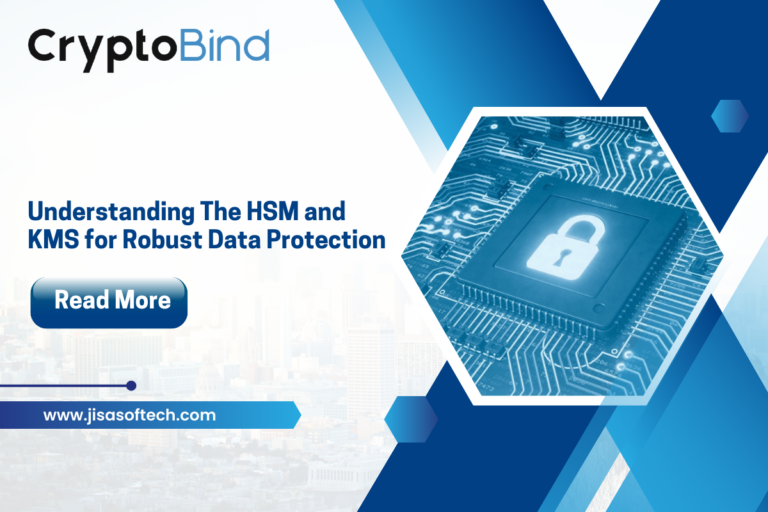How Hardware Security Module and Key Management System Interact in Enterprises?
Security compliance is an absolute requirement. Whatever the case, whether you work in digital banking, card issuance, or lending, you must keep in mind that the information about your customers, your login credentials, and your documents are all susceptible to security risks. Without effective risk management strategies, you run the risk of putting your business and your clients at risk of data breaches, cyberattacks, and extremely high fines from regulatory bodies. Here, the science of sensitive data protection known as cryptography comes to the rescue by providing the highest levels of data security.
Managing cryptographic relationships and crypto key lifecycles can be difficult. Protecting your mission-critical business applications may be simpler than you think if you have a clear understanding of how Hardware Security Modules (HSMs) and Key Management Systems (KMSs) interact and communicate with one another. Let’s discuss a Hardware Security Module or HSM, and a Key Management System (KMS).
What Is HSM (Hardware Security Module)?
A hardware security module (HSM) is a tamper-proof physical device that protects asymmetric and symmetric key cryptography’s secret digital keys. They are used to achieve a high level of data protection and trust when implementing PKI or SSH. By keeping the decryption keys apart from the encrypted data, HSMs have an additional layer of security. In this manner, encrypted data is kept private even in the event of a hack.
Most HSMs are plug-in devices that can be connected directly to a computer or a network server. The keys that HSM tools are managing are frequently safely backed up outside the HSM. HSMs are frequently used by Certificate Authorities (CAs) to generate, store, and manage asymmetric key pairs. With a wide range of use cases, HSM devices are now relied upon by a variety of industries and businesses for quick, stable, and reliable data transactions and verification.
Cryptographic Key Management:
Key management is a general term for cryptographic key management. It is essentially described as the management of cryptographic keys used in a cryptographic network to accomplish various goals.
The generation, exchange, storage, use, replacement, and destruction of keys are all covered by the fundamentals of cryptographic key management. Designing cryptographic protocols, key servers, user procedures, and other pertinent protocols are all part of the process.
A key component of any security system are cryptographic keys. In addition to user authentication, they also encrypt and decrypt data. Any cryptographic key that is compromised could cause an organization’s entire security system to fail, giving the attacker access to other sources of classified information or the ability to decrypt sensitive data.
Key management is crucial to keeping cryptosystems secure. It involves elements like system policy, user training, organizational and departmental interactions, and is one of the most varied forms of cryptography.
HSM and KMS are linked to each other through a variety of ways:
HSM devices allow you to control the cryptographic keys and how they are used, which makes them different from KMS. Let’s discuss their connection and architecture a little in the following section to get a more in-depth understanding of how these devices differ from one another.
When an HSM, for instance, performs a cryptographic operation for a secure application (such as key generation, encryption, or authentication), it makes sure that the keys are never exposed outside the HSM’s secure environment.
The KMS interacts with its dedicated HSM to generate, retrieve, encrypt, and share the keys to the authorized target when it needs to generate keys and distribute key information (secure application server or another HSM). The PKCS #11 standard, which specifies the conditions for this interaction, usually governs this communication. As a result, a collection of industry-standard APIs is used to guarantee secure communication between the KMS and HSM.
A key management system is employed to provide efficient management of the entire lifecycle of cryptographic keys in accordance with particular compliance standards, whereas an HSM serves as the core component for the secure generation, protection, and usage of the keys.
The typical key lifecycle entails key generation, key protection, rotation, distribution, and finally, retirement of these keys. The retirement of these keys must be handled with the utmost care, especially when they are in charge of protecting sensitive or valuable information like financial transactions, credit card data, etc. So, only this is the intended use of the key management systems. It makes it possible to proactively manage the keys throughout their lifecycle.
A key management server, or KMS, is typically in charge of managing the entire lifecycle of cryptographic keys via a remote PC client and is capable of safely handling both requests for inbound and outbound key distribution. Furthermore, for security and compliance purposes, these systems can keep track of audit logs for these keys. To properly generate and protect the keys, the KMS needs to be supported by its dedicated HSM for the key management team to be able to manage the key lifestyle.
Which should my business need: HSM or KMS?
To implement an encryption strategy for data security, businesses need both HSM devices and an encryption key manager. Cryptographic operations can be moved to secure areas using HSM devices. Instead, KMS can separate the key management and allow the applications to carry out their crypto functions on their own by moving the key governance to secure locations.
Contact us to learn more about HSM(Hardware Security Module), KMS (Key Management System) and how we can help you keep your organization secure.
Website: www.jisasoftech.com
Email: sales@jisasoftech.com
Phone: +91-9619222553








